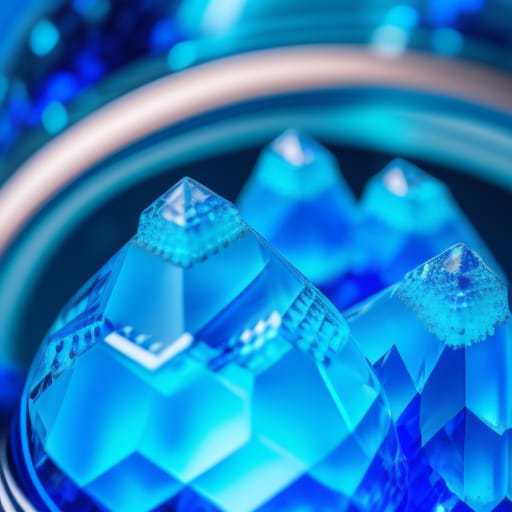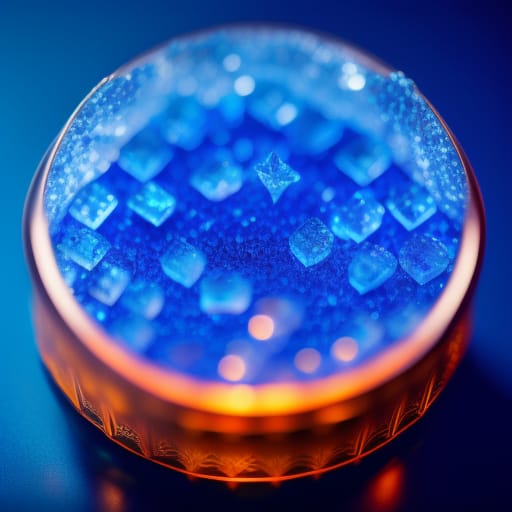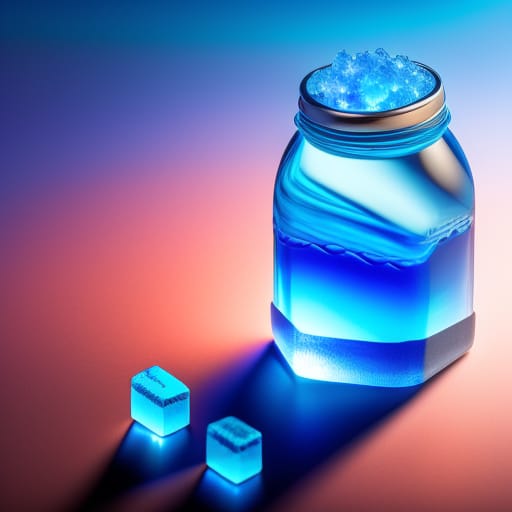Have you ever wanted to grow your own crystals at home? Crystal growing experiments are classic science fair projects that produce gorgeous, colorful crystalline structures.
Typically, these experiments use borax powder mixed with water to grow impressively large crystals. However, borax can be tricky to find and some people prefer to avoid this chemical.
Luckily, you can grow beautiful crystals using baking soda instead! Sodium bicarbonate (baking soda) works similarly to borax and makes an easy substitute for crystal growing experiments.
In this beginner’s guide, you’ll learn:
- The difference between borax and baking soda
- How to grow your own crystals with baking soda
- Tips for growing large, colorful crystals
- Fun variations to try with different types of crystals
- How to turn your crystal creations into amazing science fair projects
So let’s get started with the magical science of growing crystals at home!

Baking Soda vs. Borax for Growing Crystals
First, what is borax and how does it differ from baking soda?
Borax, also known as sodium borate, sodium tetraborate, or disodium tetraborate, is a mineral and salt compound. In its powdered form, it appears as a white crystalline solid.
Borax has many household uses, such as laundry detergent booster, cleaning product, and pest control. It can also be used in various science experiments and craft projects.
Baking soda, or sodium bicarbonate, is a common chemical leavening agent used in baking. When mixed with an acid, baking soda produces carbon dioxide bubbles, causing dough to rise. Aside from cooking, baking soda also has many household and personal hygiene uses.
While both borax and baking soda are sodium salts, they have slightly different chemical structures. However, they function similarly in terms of crystallization ability.
Here are some key differences between borax and baking soda:<div class=”table-wrapper”>
| Borax | Baking Soda |
|---|---|
| Chemical formula is Na2B4O7•10H2O | Chemical formula is NaHCO3 |
| Natural mineral compound | Manufactured chemical compound |
| Higher solubility in water | Lower solubility in water |
| More toxic if ingested in large amounts | Considered non-toxic |
| Must take safety precautions | Safer for home use |
| Grows larger crystals | Grows small-medium crystals |
</div>
The main advantage of using baking soda is safety, since it is non-toxic. Borax can cause nausea, vomiting, and other symptoms if swallowed. With baking soda, you don’t have to worry as much about accidental exposure.
However, borax does grow much larger and more impressive crystals. Baking soda crystals tend to be smaller in size. But they can still be very beautiful, colorful, and fun to grow!
Overall, baking soda makes a good substitute for borax in crystal growing experiments, especially for children or classroom settings. Let’s look at how to grow gorgeous crystals with baking soda at home.

Grow Stunning Crystals with Baking Soda
Growing crystals is an easy science experiment that produces dazzling results. With just baking soda and water, you can grow intricate, colorful crystals within a week.
Materials Needed
To grow baking soda crystals, you will need:
- Baking soda
- Glass jars or containers
- Pipe cleaners or wooden sticks
- Food coloring, liquid watercolors, or powder tempera (optional)
- Water
- Spoon for stirring
- Paper towels
Make sure to use glass jars rather than plastic containers. Glass provides the best surface for crystals to adhere to. Canning jars work well.
Step-by-Step Crystal Growing
Follow these steps to grow beautiful baking soda crystals:
- Boil water in a pot or kettle. Then pour the boiling water into your glass jar.
- Add baking soda to the jar, about 1-2 tablespoons per cup of water. Stir until mostly dissolved. Some undissolved baking soda will remain at the bottom.
- Optional: Add a few drops of food coloring, liquid watercolors, or powder tempera to tint your crystals.
- Place a pipe cleaner, wooden stick, or pencil into the jar, with part of it submerged in the solution. This will provide a base for the crystals to grow on.
- Allow the jar to sit undisturbed for 7 days. Do not move or shake the jar during this time.
- After 7 days, shining crystals should form on the pipe cleaner or stick. Carefully remove the pipe cleaner covered in crystals.
- Let excess solution drip off and lay the pipe cleaner on a paper towel to dry.
- Admire your beautiful baking soda crystals!
Growing the Best Crystals
Here are some tips for growing the best quality crystals with baking soda:
- Use boiling hot water to fully dissolve the baking soda.
- Stir the solution well before leaving undisturbed.
- Avoid moving or disturbing the jar as the crystals grow.
- Be patient – larger crystals require 5-7 days to fully form.
- Add a few drops of food coloring for colored crystals.
- Try different types of pipe cleaners or sticks as the base.
- Experiment with different baking soda to water ratios.
- Grow your crystals away from direct sunlight.
Troubleshooting Crystals
Sometimes crystal growing experiments don’t quite work out. Here are some common issues and how to fix them:
- No crystals forming: The solution may not be fully saturated to crystallize. Try adding more baking soda.
- Small crystals: Let the crystals grow longer, up to 2 weeks. Avoid disturbing the jar.
- Cloudy crystals: There is too much baking soda in the solution. Use less baking soda for clearer crystals.
- Crystals crumbling: Allow the crystals to dry fully after removing from solution. Store in an airtight container.
- Crystals won’t adhere: Try a different glass surface or stick base for the crystals to attach to.
With a little trial and error, you’ll get the hang of growing stunning crystals with baking soda and water. The results are so rewarding!
Turn Your Crystals Into A Science Fair Project
Once you’ve successfully grown baking soda crystals, turn it into an educational science fair project! Here are some ideas for experimenting with your crystal creations:
Test variables that affect crystal growth:
- Baking soda amount
- Water temperature
- Growth time
- Type of container
- Type of base material (stick)
Compare baking soda crystals to other types of crystals:
- Table salt
- Sugar
- Alum powder
- Potassium ferricyanide
Experiment with crystal structures:
- Grow crystals on different stick shapes
- Add food coloring to color crystals
- Grow crystals in different patterns or designs
Analyze crystal properties:
- Crystal size
- Crystal shape
- Crystal color
- Crystal hardness or durability
Choose one variable to test or one comparison to make. Set up multiple jars with controlled variables. Take detailed notes on observations. Display your crystals and findings on a science fair poster.
Growing colorful crystals makes for an eye-catching and intriguing science fair project for all grade levels. Learn more about the chemistry behind these crystal creations!
Grow Different Types of Impressive Crystals
Baking soda crystals look gorgeous, but you can grow many other types of crystals for unique structures and colors. Here are some fun variants to try:
Rock Salt Crystals
For another edible crystal, grow large cubes from plain table salt. Mix salt with hot water until no more dissolves. Add a stick and allow salt crystals to slowly form over 7+ days.
Sugar Crystals
Sugar and hot water create sugar crystals with a sweet twist! Boil water and stir in sugar until saturated. Sugar crystals that form are sparkly white.
Alum Crystals
Alum powder produces crystals with a cool, metallic sheen. Mix powdered alum with hot water and food coloring. Allow spiky, octahedral alum crystals to form on a stick base.
Copper Sulfate Crystals
This chemical compound grows vivid blue crystals. Copper sulfate powder is dissolved in distilled water, then allowed to crystallize on a stick or glass surface for bright blue colors.
Potassium Ferricyanide Crystals
Also known as red prussiate of potash, this chemical forms ruby red, metallic-looking crystals. Mix powder with water and allow crystals to form. The vivid color comes from iron compounds.
There are tons of cool chemicals and compounds you can crystallize at home with amazing colors and shapes. Get creative with different types of crystal growing experiments!

The Science Behind Crystal Formation
Now that you know how to grow impressive crystals, let’s look at the science behind crystal formation and growth.
What Are Crystals?
Crystals are solids made up of a repeating, orderly molecular structure. The molecules align themselves symmetrically in a molecular lattice. Minerals and certain materials produce crystalline solids.
Some characteristics of crystalline solids:
- Regular, repeating molecular patterns called the crystal lattice
- Specific geometric shapes based on the type of crystal lattice
- Smooth, flat planar surfaces called crystal faces
- Rigid and stable structure
- Anisotropic – properties vary by directional axis
- May have flaws called crystallographic defects
Crystalline structures form because the orderly alignment allows particles to pack tightly together, minimizing energy. Certain conditions must be met for crystal growth to occur.
Crystal Nucleation and Growth
For crystals to form, dissolved particles must nucleate and build up on a crystal “seed”. This occurs in two main steps:
- Nucleation – Solute particles cluster together on a nanoscale into an organized crystal arrangement called a nucleus. This only occurs once the solution reaches supersaturation.
- Crystal Growth – The nucleus attracts more solute particles that adhere to the repeated crystal lattice pattern. Layers of particles deposit along the crystal faces. Given enough time, this produces macroscopic crystalline solids.
Supersaturated Solutions
In order for nucleation to occur, the solution must be supersaturated. This means more solute is dissolved than the solvent can normally hold at that temperature.
Adding heat allows more solute to dissolve into the solvent. As the solution cools, the excess solute must crystallize out since the solvent is oversaturated.
Controlling Crystal Growth
Several conditions affect crystal formation and growth:
- Solute concentration – Higher concentration = faster growth
- Temperature – Warmer temperatures = faster growth
- pH – Can affect solubility and lattice formation
- Purity – Impurities distort the crystal structure
- Motion – Stirring or vibration encourages growth
- Seed crystals – Provides a base for crystals to grow on
By controlling these conditions, you can grow large, high-quality crystals for experiments and projects.
Crystal Experiments Teach Fascinating Chemistry
Growing colorful crystals is not only mesmerizing but also an excellent way to learn science. Crystallization allows you to visually see molecules arranging into geometric, symmetric patterns.
Watching crystals slowly form before your eyes illustrates key chemistry concepts like:
- Solubility
- Saturation
- Supersaturation
- Crystallization
- Precipitation
- Polymorphism
- Lattice structures
- Intermolecular forces
Understanding these concepts is fundamental to learning more advanced chemistry later on. Plus, no chemistry lab is complete without creating crystals!
What is the best temperature to grow baking soda crystals?
The hottest water possible helps dissolve the most baking soda to create a supersaturated solution. Boiling or near-boiling water is ideal. As the solution cools to room temperature, crystals will begin forming within a few days.
How can I make the largest baking soda crystals?
To grow large crystals, use hot water and stir in baking soda until no more dissolves. Use glass jars and avoid disturbing the solution as crystals grow. Allow at least 1-2 weeks for full size crystallization. Adding seed crystals helps produce big crystals.
What causes cloudy crystals?
Cloudiness means tiny crystals formed rapidly. This is usually due to too much baking soda in the solution. For clear, glassy crystals, use less baking soda or more water to slow down crystal growth.
Can I grow crystals without food coloring?
Yes, you can grow plain white baking soda crystals without any added color. The food coloring simply provides vibrant colors. But the crystal structure will form with or without it.
Is it safe for kids to grow baking soda crystals?
Baking soda is non-toxic, so crystal growing experiments are safe STEM activities for children. Supervise young kids and remind them not to ingest any materials. Borax should be avoided for children due to toxicity if swallowed.
What other chemicals can be crystallized?
Many compounds can be crystallized at home in addition to baking soda. Common chemicals to try are epsom salt, table salt, sugar, alum powder, saltpeter, copper sulfate, and potassium ferricyanide.
Let me know if you need any other crystal growing questions answered!